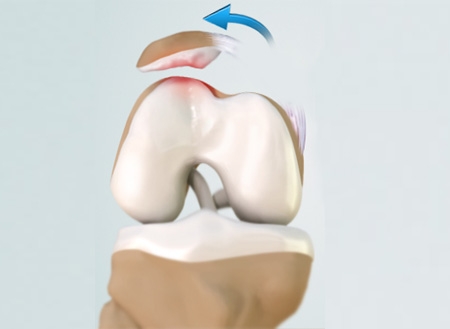We often hear patients with knee cap (AKA patella) instability state that their ‘knee popped out.’ Though it is true that a bony structure is pathologically moving and likely causing a popping sensation, it is not the knee itself. A true knee dislocation where the tibiofemoral articulation becomes displaced is a true medical emergency, and we don’t say those words very often in our world of orthopedics. What more commonly occurs is a patella dislocation where the patella shifts outside its groove. Though painful and problematic, a patella dislocation is not a medical emergency. It does, however, require orthopedic attention.
A patella dislocation indicates that the patella bone shifted outside the patellar groove. These instances often occur with either pivoting and twisting activities or a direct blow to the knee. Most commonly, the patella shifts to the lateral (or outside) aspect of the knee. It is rare to sustain a medial patella dislocation, though certainly possible with the right kind of force. Sometimes the patella will reduce (or realign) on its own. Other times, it requires manual force to relocate the bone structure.
Regardless of how the injury occured, orthopedic care is recommended. It is important to obtain x-rays of the knee to confirm that the patella is indeed sitting appropriately in its groove once again as well as to confirm that no fracture occurred at the time of injury. When a single patella dislocation occurs, conservative management to include a brief period of bracing for support and a course of physical therapy to slowly regain strength and motion will allow someone to gradually return to their daily activity.
If one dislocation leads to another which leads to another and the instability becomes chronic, further intervention may be necessary. Your physician will order an MRI to further assess the soft tissue structures like tendons, ligaments, and cartilage for possible surgical planning. If fairly normal anatomy is present, a surgical procedure called an MPFL (or Medial PatelloFemoral Ligament) reconstruction may be discussed. This surgery reconstructs the soft tissue that sits on the inside of the knee and helps prevent the patella from shifting laterally. Other types of corrective surgeries exist that are indicated when the anatomy is not ‘normal’ such as deepening a shallow patellar groove to prevent further dislocations or re-aligning the patellar tendon to improve tracking. Your surgeon will help determine what the best procedure is for your knee. These can be daunting surgeries to undergo, but It can provide excellent results to patients who struggle with chronic patella dislocations that prevent them from participating in the activities that they enjoy.
If you are having issues with your patella not wanting to stay where it belongs, give us a call today to schedule a consultation with one of our board-certified knee specialists.
This blog is written by one of our very own-Morgan. She is a certified athletic trainer working in our clinic with our providers each and every day. She obtained a bachelor's degree in athletic training from Carroll University in Waukesha and a master's degree in Kinesiology from Michigan State University.

